Barb Winters's Blog, page 3
January 10, 2025
Opening My Eyes to the Realities of Sex Trafficking
January is Human Trafficking Awareness month. I met Jessica Brodie last fall and learned of her passion to educate others about the sex trafficking issue plaguing our society. Jessica offers insight and wisdom to us in her post.
Like many people, I used to make a lot of assumptions about sex trafficking—I assumed it only happened in “those” neighborhoods or to “those” kinds of kids—girls who didn’t know better, or whose moms were in the sex industry. I assumed the girls knew what they were getting into and simply made a choice—a bad one, but one they made with eyes wide open.
Then it hit close to home, when I learned about a young girl in our relatively wholesome community who’d somehow gotten lured into this mess. By the time her parents were able to track her down, out of state and by then deep in the throes of addiction and crime, she’d become a shell of her former self. It took years to heal from the trauma, and I suspect the nightmares will haunt her for a lifetime.
That’s when I learned about grooming and online chat rooms, about drug parties and quick-cash home movies, about blackmail and other sneaky, perverse, calculating tactics employed by both men and women. I learned how easily twisted, manipulative adults posing as teenaged boys or new and enticing female “friends” are able to lure young girls in with fine-tuned bait, appealing to their darkest or most desperate desires.
Like wolves isolating that lone, wounded sheep from the rest of the flock, they circle in on these girls and draw them to the outskirts, where—vulnerable and alone—they get sucked in to The Life … sometimes, never to return.
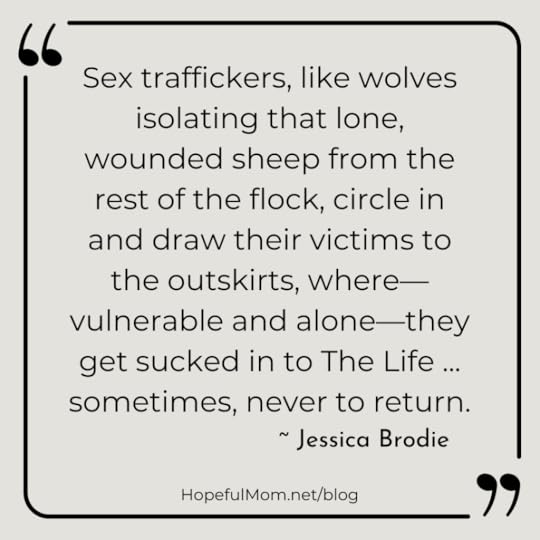
For just like victims of domestic violence are brainwashed and gaslighted by people they love and trust, so too are victims of sex trafficking.
My eyes are open now, and I can’t unsee what I now know.The reality is that sex trafficking is everywhere. It’s in your neighborhood and mine. And it’s up to us as parents to open our eyes and do something. Raise awareness. Educate. Advocate … before it’s too late.
I have four teens, including two seventeen-year-old daughters, and rest assured I’ve had these conversations with them. Even though it makes them uncomfortable to think about, it’s critical they know not every guy on Snapchat or Instagram with a cute profile picture is actually their age. It’s critical they know how easily it can happen.
The Deliver Fund, a nonprofit intelligence agency that combats sex and other human trafficking with counterterrorism expertise, estimates that between 15,000 and 50,000 women and children are forced into sexual slavery in the United States every year. Most are female, though males are trafficked, too, for the same reasons.
And because so much of sex trafficking happens behind closed doors, in secret, it’s hard to gather accurate statistics.
In fact, according to the Polaris Project, many people in sex trafficking situations don’t even recognize themselves as “victims” because they’ve been so expertly groomed by a trafficker.
Many victims of sex trafficking don't recognize themselves as victims because they've been so expertly groomed. Read more here. #humantraffickingawareness Opening My Eyes to the Realities of Sex Trafficking
Share on X
As one survivor of trafficking stated on Polaris Project’s website, “It took me ten years to realize: Hey. Wow. I was trafficked, because my situation was so different from what I had seen represented as trafficking.”
Sex trafficking can look like a lot of different things, but ultimately it involves selling one’s body for sexual acts. It can include prostitution for a pimp on the streets; gang requirements or initiation; group housing arrangements, where a homeless teen might get a place to live in exchange for sexual favors; and drugs-for-sex swaps, when someone gets free drugs for a while, then once they’re addicted, they must exchange sex acts for the drugs they now crave. In some cases, young women eager to land modeling jobs might be told they need to “be nice” to clients in order to land a coveted photo shoot—only, the agent isn’t reputable, and those photo shoots never come.
And it’s all happening all over the place, in big cities and suburbs, in farming communities and low-income projects, right under our noses with our daughters, and sometimes our sons.
Predators are out there, just looking for a foothold. Waiting for that kid who’s mad at her parents and itching for payback. Waiting for that kid who’s curious about drugs and doesn’t suspect ulterior motives when offered free samples for weeks on end.
The advent of smartphones, social media apps, and light parental restriction makes their job all the easier.
What can you do?Get educated. The Polaris Project has some excellent example scenarios of sex trafficking here so you can understand how easily it can happen.Keep lines of communication open with your kids starting at a young age. I’ve been talking about sex with my kids since they were too young to be embarrassed about it—both good, God-designed sex (in a loving, married relationship) and bad.Don’t stop talking when they get older and start to get embarrassed. I’d much prefer my kids find out scary facts or truths from me than from their friends or the internet. That way we can talk about it. Share news stories, or ask questions when you hear about things happening in your community. Shine light into the darkness.Monitor their phones, tablet, or laptops. Make sure you know what social media apps they’re on, and don’t just offer blanket approval when they ask to download something.Share what you know wherever you can. I’m a journalist and an author, so I use my platforms to speak out when I can, whether it’s the blog you’re reading today, an article I wrote that might appear in a newspaper or online magazine, or a novel. My faith-based novel Hidden Seeds (not yet published, but coming soon) features a protagonist who has escaped a life of sex trafficking and is starting over with her young daughter under a new name. Whether it’s your church, home, workplace, or community, consider how you can share what you know so all may see the light.Too many times, we assume bad things happen in places far from us, that we’ve built an ironclad home and family unit that couldn’t possibly fall to attack. But as the Bible tells us, “Your enemy the devil prowls around like a roaring lion looking for someone to devour” (1 Peter 5:8 NIV). There’s no room for ignorance or wishful thinking when it comes to defending ourselves and our young people against evil.
Thanks for reading. Please spread the word about human trafficking by sharing this post.
The post Opening My Eyes to the Realities of Sex Trafficking appeared first on HOPEFUL MOM.
December 26, 2024
Self-Care for the New Year
As December turns to January, tradition dictates that we reflect on the past year, shed unhealthy habits, and resolve to live a healthier lifestyle. A fresh start.
Easier said than done. Parenting never ends and doesn’t make room for reflection or renewed routines.
If you think life’s too busy to take care of your physical, emotional, and mental health, you’re not alone. According to 2023 data, “48% of parents say that most days their stress is completely overwhelming compared to 26% among other adults.”[i]
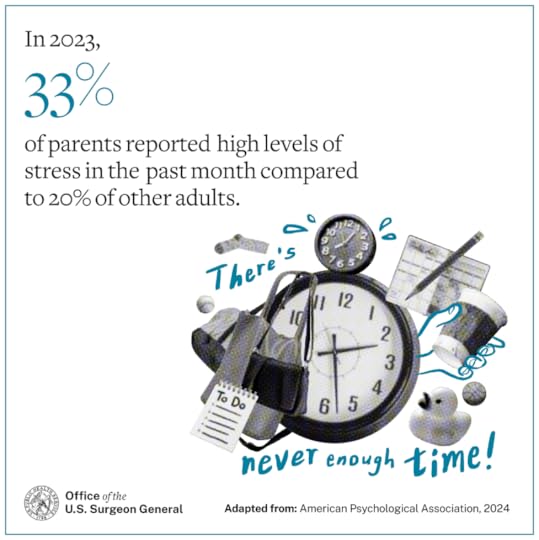
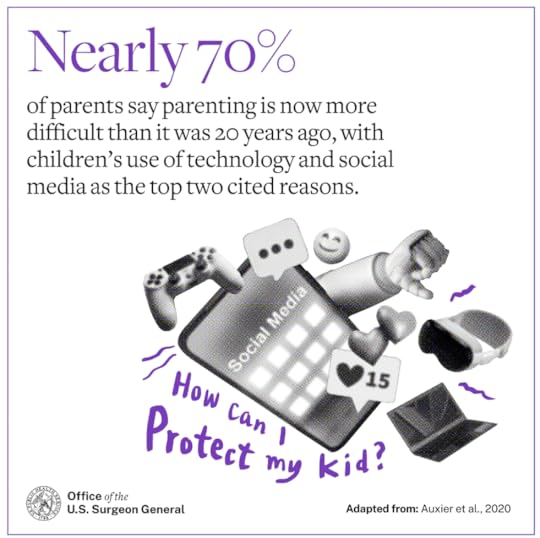
According to the U.S. Surgeon General’s Advisory on the Mental Health & Well-Being of Parents, parent stressors include financial strain, time demands, children’s health, cultural pressure, and technology and social media. The advisory states, “Nearly 70% of parents say parenting is now more difficult than it was 20 years ago, with children’s use of technology and social media as the top two cited reasons.” Over half of parents of adolescents are worried their child’s social media use could lead to anxiety, depression, lower self-esteem, or being harassed or bullied. Seventy-one percent are worried it will lead to exposure to explicit content.[ii]
How do we relieve some of this pressure?
Self-care is a must.In my early days of homeschooling, afternoons included quiet time for my kids and me. My children’s bodies no longer required naps, but I still needed a break from the constant interaction with little ones. I ushered them into their bedroom to read a book or listen to an Odyssey tape. (Yes, I said “tape.” It’s something you put into a tape recorder to hear a story. Sometimes it was a CD. This was way before streaming. But I digress.)
I went into my bedroom and prayed, read, or, sometimes, slept. I needed the time alone—to gather my thoughts and rejuvenate my body. When my children objected, I reminded them, “Quiet time is for mommy. Mommy is a better mommy after quiet time. She’s happier and more loving, which affects how she interacts with you. So quiet time is a must for mommy.” And it was true, especially on days I felt stressed about all the things.
Self-care is not selfish. Self-care assists us in being the best parents we can be. Without it, stress builds. It impacts our mental and emotional areas of life, eventually affecting our physical, spiritual, financial, and relational health. Self-care, taking care of our well-being, is the answer.
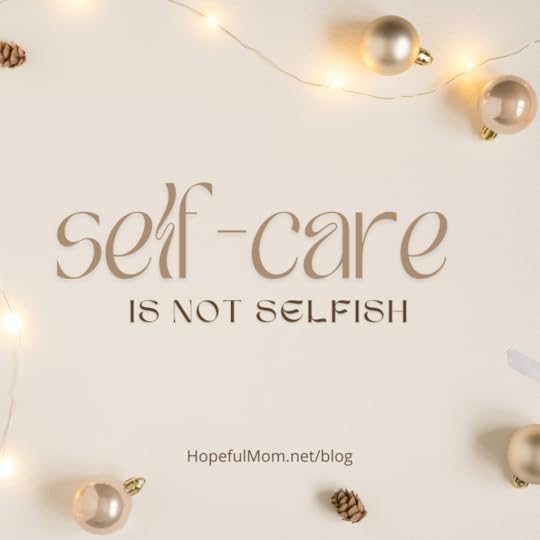 What does self-care look like?
What does self-care look like?While self-care is different for each of us, certain core elements need addressed.
Physical. What physical activity do you enjoy? An important part of my day is short walks. I walk for ten minutes around my neighborhood at least twice a day. This gets me out of my desk chair, helps clear my mind, and keeps my body mobile. To maintain a healthy heart, I work out 20-30 minutes a few times each week.
Self-care in the physical area of life also includes proper eating and sufficient sleep.
Spiritual. How do you feed this part of your life? Prayer? Meditation? Reading? Attending weekly services? While we may not all practice the same religion, nurturing this area is vital. Feeding our soul inspires creativity and nurtures hope.
Emotional. What emotions hijack your brain? When we experience out-of-control emotions, we can practice breathing exercises and set boundaries. When feeling angry or agitated, we can stop and evaluate our circumstances. Ask yourself what initiated the response and what can be done to deescalate the runaway emotions. Figure out how to prevent the same reaction in the future.
Mental. What activity brings you joy? Whether it’s reading, painting, or horseback riding, pursuing an endeavor which lifts our spirits helps our mental well-being.
Social/Relational. What social activities bring you pleasure? Whose presence warms your heart? Go for coffee with your friend. Invite colleagues over for a game night. Call the family member who makes you laugh.
Spending time with others is not self-indulgent. On the contrary, when we surround ourselves with people who pour into our lives, we treat others better.
Your TurnOpen your calendar and schedule time to evaluate your self-care habits. Carve out space to add in self-care activities. You’ll be grateful you did. And so will your children.
WORKSHOP – JAN 5, 2025
If you live close to Madison, FL, you’ll want to attend this essential workshop! Barb Winters empowers parents to navigate conversations with their children about online safety. From accidental pornography exposure to online predators, all children are at risk. Barb draws on her personal experience and professional insight to equip you with the skills necessary to address these challenges confidently. Join me for this workshop at Fellowship Church in Madison, FL.
Be sure to share this information, along with this website, with your friends.
Happy New Year![i] https://www.hhs.gov/surgeongeneral/priorities/parents/index.html
[ii] https://www.hhs.gov/sites/default/files/parents-under-pressure.pdf
The post Self-Care for the New Year appeared first on HOPEFUL MOM.
December 9, 2024
Victors in the Battle for Sexual Integrity
I’m thrilled to introduce Teri White, an incredible advocate for sexual risk avoidance education. Teri works directly with schools, equipping students with tools for healthy decision-making, and has also developed a curriculum to help parents teach their children about sexual integrity. I had the pleasure of meeting Teri in person at a homeschool conference and was immediately drawn to her warm and engaging personality. As two retired homeschool moms now dedicated to guiding students toward healthier choices, we share a deep passion for this work. It’s an honor to share her insights in this post.
E. Stanley Jones wrote, “Sex has produced more happiness and more unhappiness than any single thing in life. It all depends on what you do with it.”
These words crafted by Jones are on point. The battle for sexual integrity has been fought since the beginning of time by all individuals, young and old alike. Every person born on earth will, at some point, make the decision to live to the highest of moral standards about their own sexual behaviors or avoid it all together. Because this is a battle of great magnitude, it is imperative that individuals are prepared and equipped to face the struggle without fear. But how? How does one become combat ready and equipped to engage in the battle?
More importantly, how does one prepare their children to be conquerors in the battle for sexual integrity?
Instruction in sexual integrity has long been a taboo topic that often has been avoided. Parents have been apprehensive to discuss it for a multiplicity of reasons and some have completely avoided any semblance of this conversation with their children. Perhaps a parent did not hold to the highest of moral standards when they were a young person and are now embarrassed or shamed regarding their personal weaknesses and mistakes. Teachers, some of which are mandated by state boards of education, have been reluctant to talk about the truth of sexual integrity, often due to their own lack of knowledge, misunderstanding, and fear. Some churches have attempted to touch on the subject but not always in a positive manner.
"Youth will be exposed to issues of sexual integrity. Empower them to walk into the battle equipped." ~ Teri White, Victors in the Battle for Sexual Integrity #hopefulmom #healthyrelationships
Share on X
Fast forward over time and the purity culture enters the scene. Although promoted by well-intentioned individuals with positive motives, the purity culture movement brought its own set of problems to the discussion. Teaching was readily conducted on what not to do regarding sexual behavior, yet rarely was teaching conducted on the beauty and benefits of positive sexual behaviors within a faithful and loving marriage. A disturbing narrative emerged that was based on shame rather than the beautiful intimacy that should be cultivated within a healthy marital relationship.
What was the result of the timidity and shame-based teaching? A lot of confusion which involved generations of people growing up ignorant and full of questions on how to navigate their emerging sexuality. Countless individuals learned about sexual integrity the hard way, by trial and error. This method of learning (or lack of learning) led to individuals making numerous mistakes which resulted in not so positive outcomes such as unintended pregnancy, disease, and/or emotional harm. Add in individuals that were introduced to abusive sexual behaviors against their will and as might be expected, another huge dynamic of problems ensued surrounding the battle of understanding sexual integrity.
Past culture may have been timid, but current culture is no longer quiet or shy about this topic. Sex is everywhere! It can be found in books, music, movies, video games, the advertising industry, and the social media on which everyone’s eyes are glued. If a young person (or old person for that matter) has a phone, iPad, or laptop they will be exposed to the issues of sexual integrity even if they are not intentionally searching. If a young person does not have a phone, iPad, or laptop they will be exposed to issues of sexual integrity from friends. The greatest travesty? These problems could be prevented. The dilemma goes back to the original question, “How does one become combat ready and equipped to become a victor in this battle?”
The answer is simple, Sexual Risk Avoidance Education.
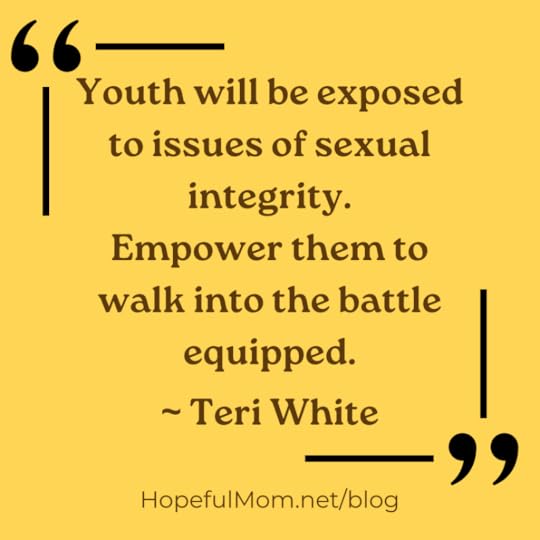
AIM (Acknowledging Integrity Matters) is a Sexual Risk Avoidance (SRA) program designed to flip the switch on this subject and get parents, teachers, church members, and young people comfortable talking and learning about sex and the sexual integrity principles that desperately need to be instilled in all people. The current culture has twisted and distorted sex into something that was never intended. Humans were designed as sexual beings from the beginning. Even on a microscopic level our cells testify to the beautiful design of sex and intimacy.
The original design for sex was perfect and beautiful but only within the limitations of marriage between a husband and wife. When sex moved outside the boundary of marriage, it turned into something it was never meant to be. Ultimately, the Creator of the Universe designed this relationship to mirror Christ’s love for His church and the beautiful intimacy that was created by Him.
If you have a young person in your life, introduce them to this beautiful intimacy in a healthy manner that addresses sexual integrity from a holistic perspective. Empower them to walk into the battle equipped and as Jones wrote, help them to understand “what to do with it.” Give them the tools to make healthy decisions and aim them in the direction of being victors in the battle. If you would like more information about AIM, to schedule a speaking presentation, or to schedule a coaching session contact me at teri@stillwaterslife.com.
Looking for a Christmas gift for a parent in your life? Check out the list of parenting books here. Need a family gift or a non-electronic game for your children? See this list of games I recommend.
The post Victors in the Battle for Sexual Integrity appeared first on HOPEFUL MOM.
November 11, 2024
Benefits of Parenting with Gratitude
“The root of joy is gratefulness… It is not joy that makes us grateful; it is gratitude that makes us joyful.” ― Brother David Steindl-Rast[i]
Parenting is fulfilling. But it’s also relentless, scary, and full of disappointments. Days are long. Tasks are repetitive. Problems are nonstop. If we’re not careful, months pass without a pleasant thought, and our mental health spirals. Add a child who makes unhealthy choices, and we can collapse into a trance-like state pretty quickly. We squash our lofty goals into one: simply making it through each day.
Several years ago, I read One Thousand Gifts. I learned the power of thankfulness. On a dare, the author, Ann Voskamp, began a Gift List. Not of gifts she wanted, but of gifts she already had. And it transformed her life. She learned that deep joy is “found at the table of thanksgiving.”[ii] Over time, Voskamp wrote one thousand gifts she saw or experienced, and joy replaced despair.
With the Month of Gratitude at hand, let’s explore how we can demonstrate a thankful attitude, even during the sometimes difficult task of parenting. Then we’ll explore benefits of parenting with gratitude.
Tips to an Attitude of GratitudeObserve – I’m learning to lift my eyes and look around. To peek over problems and look beyond the immediate issue. When my printer breaks down, I’m thankful to own a printer. When I’m interrupted for the fourteenth time, I’m grateful for family, friends, and colleagues who think of me. And when my child falters or hurts, I thank God for their life and my availability.
Shift Perspective – Photography makes me happy. When I look through the lens, I’m forced to see the world from a different angle. Where is the best lighting? What if I crouch or stand on my toes? How does that change my perspective and help me understand the subject matter better? My favorite photos show a deeper story, capturing more than what’s apparent. Searching for the perfect photo compels me to find beauty in the midst of ugliness. We can do the same in any situation. Rather than focusing on the glaring ugliness, we can search for the beauty in our circumstances.
When overwhelmed, we can remember a time when we were content or create a list of things we appreciate. House, food, clothing, job, etc. This reminds us that not every little thing is doom and gloom.
Examine Details – Sometimes we have to search for a small detail – something minute – to ignite our thankfulness. When the baby cries for hours, we’re grateful she has lungs that work and a way to communicate. When a teen complains, we remind ourselves of one positive characteristic he possesses.
Pause to Thank – When we notice our emotions are unstable, we can intentionally pause and take a moment to reflect on what we appreciate. Refer to that list I talked about in “Shift Perspective.” I consistently thank God for what He’s allowed in my life and what He’s teaching me through my trials.
Embrace Grace – Fear, worry, and anxiety rob us of joy. Offering grace to ourselves and those around us chases these away. When we choose forgiveness and drop control, we become more gracious and thankful. And we are more joyful.
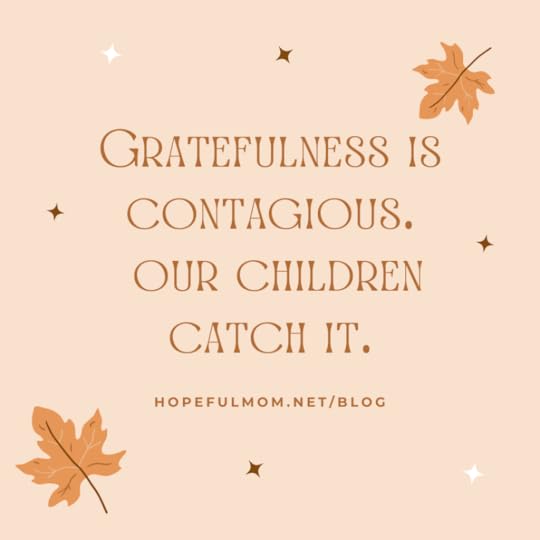 Benefits of Parenting with Gratitude
Benefits of Parenting with GratitudeHealthier Relationships – When we search for personality traits in others that we appreciate and maintain a grace-filled attitude, our relationships are strengthened. We approach situations with a calmer presence which decreases tension in a conflict. This is especially helpful on those parenting days we feel unseen, unheard, and unappreciated.
Improved Mental Health – When we are thankful, we are less stressed, less anxious, and less likely to be depressed. We are happier.
Improved Physical Health – When we are grateful, we sleep better and have better immune systems. We get sick less often and are more active.
Increased Productivity – When we see the positive around us, our spirits are lifted. Therefore, we are more productive.
An Infectious Attitude – Attitudes that reflect joyfulness and gratefulness are contagious. My husband noticed my thankful attitude and the residual effects. He now pauses and expresses gratitude during trying moments more often than he had. When we are parenting with gratitude, expressing thankfulness either outwardly or inwardly, our children notice. And whether they realize it or not, our disposition rubs off on them.
Gratefulness is contagious. Our children catch it. #parentingwithgratitude #thankfulness #hopefulmom #healthyrelationships Benefits of Parenting with Gratitude
Share on X
Parenting can be depressing if we allow it. But raising children also has rewards. We can pause and ponder the personality traits in our children that make them special and choose to reflect on their behaviors that fill us with gladness. We can contemplate past interactions that made us smile. Then broaden our list by examining our surroundings and thanking God for our possessions. We can meditate on the people in our life and how each positively influences us. Let’s continue our list throughout the day and into tomorrow and next week. And reap the benefits.
I’m excited to announce that the audio version of Sexpectations: Helping the Next Generation Navigate Healthy Relationships is on sale at audiobooks. Use this link before 12/1/24 for 60% OFF. . . . While Christmas shopping, check out the family games suggestions on this page, and pick up a copy of Sexpectations for a mom you know.
[i] Goodreads. (n.d.). A quote by David Steindl-Rast. Goodreads. https://www.goodreads.com/quotes/2865...
[ii] Voskamp, A. (2010). One Thousand gifts: A dare to live fully right where you are. Zondervan.
The post Benefits of Parenting with Gratitude appeared first on HOPEFUL MOM.
October 21, 2024
How Not to be “Late to the Party” When Talking to Your Child About Sex
I’m thrilled to introduce Jackie Brewton. Jackie has years of experience equipping parents on how to talk with children about sex and related topics. I love the advice she gives us in this guest post.
Parenting teens in today’s culture is NOT for the faint at heart, which is why I always want to make sure my content addresses parents’ struggles, challenges, or needs.
Whenever I get a question from one person, I know that could be on the minds of other parents as well.
Recently a mom posted a question on my Facebook page and I thought other parents could benefit from the answer I gave her:
Mom: My son is eleven and a rising 6th grader. He seems to be on the cusp of puberty as it relates to his body changing and has mentioned having a crush during this school year.
What should we be discussing about “having sex or understanding what it is” right now?
I love reading your posts daily and don’t want to be late to the party, thinking we aren’t there yet, or he isn’t ready.
This Message Applies to Your Teen Too!Even though her question was about her 11-year-old son, my answer applies to your teen daughter or son as well.
This was my response:
Before you have a conversation about sex, I would focus the conversation on love and healthy relationships. And I do not just mean romantic love, but love in general. What does love do?
How does love treat others?
Before talking about sex, focus conversations on love and healthy relationships. Advice from Jackie Brewton at the latest post: How Not to be “Late to the Party” When Talking to Your Child About Sex #hopefulmom #difficultconversations
Share on X
When it comes to influencing your son’s relationship choices, just as much will be caught as is taught. So, make sure healthy relationships are being modeled. How your son sees your husband treat you will have a significant impact on how he will treat the young ladies he dates.
I also know he has a little sister, so remind him how important it is for him to be an example to her about the type of behavior she will accept from anyone she dates. And challenge him to not do anything with any young lady he dates that he wouldn’t want someone to do with his sister.
I would let him know that what he’s feeling is normal, but I would also have conversations with him about how temporary relationships typically are in middle and high school.
In fact, this is what I tell students in my classes:
Most teenagers are dating their future ex. They will either get married or break up. And as a teenager, the chances are MUCH, MUCH greater that they will break up than marry. If you recognize that one day the other person will become your ex, that should impact what you choose to do in that relationship. Why would you do anything in a temporary relationship that could come with a permanent consequence?
Use the media to start conversations about what is appropriate and inappropriate behavior related to relationships/sex. Make sure you focus on the good examples just as much as you focus on the bad examples.
My strategy is always to teach toward something (dreams/goals) instead of away from something (negative consequences). I have found it to be much more effective.
If you make sure your son has dreams and goals for his future, the sex conversation, though necessary at some point, will not need to be at the forefront because he’ll realize that nothing is worth him risking his future dreams and goals.
Of course, I would definitely read my book, The Truth About Sex: Real Stories from Teen Guys Like You, WITH him by the time he’s 13 at the latest. [I would make the same recommendation for a parent of a daughter with my book, 7 Secrets Guys Will Never Tell You: A Teen Girl’s Guide on Love, Sex, and Relationships.]
I know how handsome your son is, so you’re going to have to prepare him for those girls who may be the aggressor. He’ll need to be taught refusal skills just as much as you teach them to your daughter. Role play scenarios with him to help him figure out in advance how he would handle them.
I applaud you for asking the question now and “not wanting to be late to the party.”
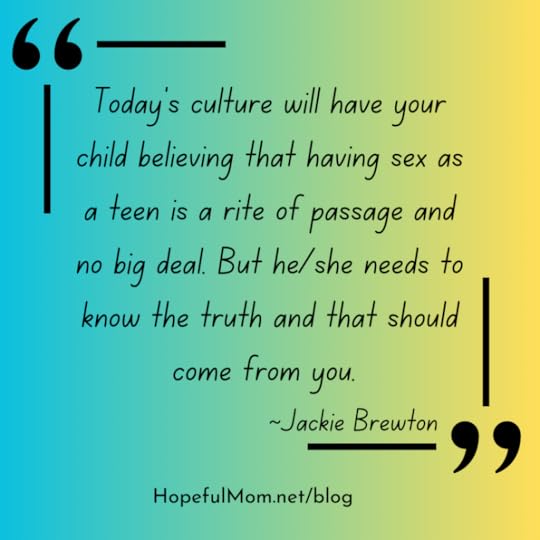 Don’t be Late to the Party!
Don’t be Late to the Party!I genuinely believe parenting teens, especially in this day and time, is one of the toughest jobs there is.
And it’s not the teens themselves, but the culture they live in that makes it all the more challenging for parents to guide their children towards realizing their dreams and goals while navigating the countless landmines waiting to blow up their future.
As much as I am called to empower teens like your son or daughter, I am also on a mission to equip parents like you to help your child make positive choices now that will set him/her up for success as an adult.
So don’t be late to the party!
Start implementing the tips shared in today’s post with your son or daughter today.
P.S. Today’s culture will have your child believing that having sex as a teen is a rite of passage and no big deal. But he/she needs to know the truth and that should come from you. Sex is a temporary act that could permanently hinder your child from realizing his/her dreams and goals. And that is a big deal! So don’t wait. Start having these conversations with your child TODAY. And for additional resources on this topic, go here to check out my resources for teen girls and teen guys.
Subscribe below for two FREE downloads. If you need counseling because your child has been exposed to pornography, check out the information here.
The post How Not to be “Late to the Party” When Talking to Your Child About Sex appeared first on HOPEFUL MOM.
October 9, 2024
Youth Show Friends Porn
“My 9-year-old son told me our neighbor boy, his friend, described pornographic scenes he saw in detail to him. My son is traumatized.”
I read the above on a Facebook page I follow. The parent went on to say she was caught off guard. Even though she’s talked with her child about sex and puberty, she was waiting to talk about pornography. Below the original post, parent after parent described similar circumstances with their children.
Youth show their friends porn.“Yes, it happened to my 10-year-old at a sleepover. I was not prepared and neither was the other mom.”
“My child was introduced to porn by a classmate at school at age nine. We didn’t find out until our child was 12.”
“My daughter was exposed to adult contact at 11.”
“I had to talk to my neighbor about something similar. It’s so hard when the children grew up together and you now have to talk with them about this.”
Friends show friends porn. Unfortunately, this behavior is common and can be devastating for the child and heartbreaking for parents.
Children are typically exposed to pornography one of three ways. They accidentally stumble across it, they are curious and do a search and find it, or a friend shows them. Youth show their friends porn. It’s an unfortunate fact, but a fact nonetheless. So we need to be mentally prepared and be proactive in our parenting.
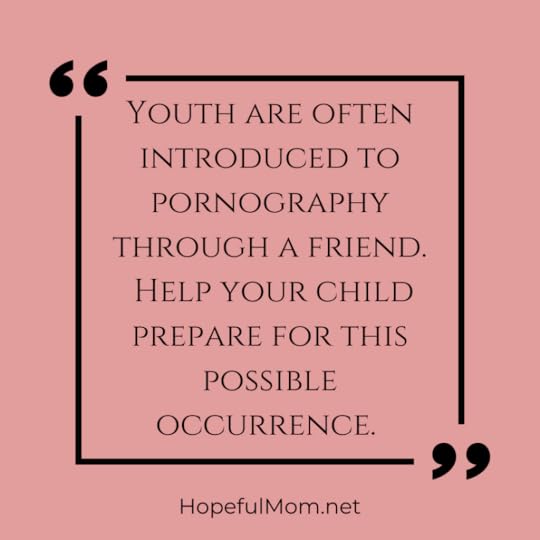 Start Conversations Early
Start Conversations EarlyWe can be proactive by starting conversations about pornography and its dangers at a very young age. Pornography is everywhere and its preying on our children. (Do I sound like a broken record? Yes, I’ve mentioned this before, and I will continue to state it as long as the pornography industry exists.) Therefore, our best offense and defense is talking about pornography with our children.
We shouldn’t be afraid of the conversations. We warn our children about other dangers in the world. Don’t put your finger in an electrical socket. Don’t touch a hot stove. Add one more . . . Don’t look at bad pictures, ones that show areas that should be covered (the underwear zone) or are intended to make us think inappropriate thoughts. Fill in the blank with correct anatomical terminology and adapt the conversation to your child’s age and maturity level.
More AdviceIn the post I mentioned above, after her child told her what happened, the parent told him how proud she was of him for telling her. The parent reminded her son that curiosity was normal but the internet has confusing and dangerous things.
In the comment section, parents offered fantastic advice to this hurting parent.
“Remind him you are available to listen if he has follow-up questions or just wants to talk.”
“Let him lead the conversation, listen, and allow him to express his feelings.”
“Be open and honest. Explain sex using correct anatomical terminology, and explain when it’s appropriate to have sex.”
“Explain that pornography is not the same as real life. It’s unrealistic, objectifying, and violent.”
“Be careful of other children who show pornography. That’s how child-on-child abuse begins.”
“Seek out a counselor for your child, if necessary.”
One parent suggested role play, an excellent idea. Role playing provides children with practical tools for future use. Whether your child has been exposed to pornography or not, sit with him or her and go over several scenarios in which they may be exposed to pornography. Then brainstorm some responses.
Here’s one example: If a friend says, “Hey, look at this,” and holds a device out for you to view, what will you do? After listening to your child’s response, you may suggest that instead of just looking at the device, they could first ask, “What are you going to show me?” If the friend indicates the video or photo may be inappropriate, empower your child to say, “No, thank you. I don’t want to see it.”
Youth will show their friends porn. Your child is likely to be exposed. So, help your child be ready and prepare yourself for the inevitable. You’ve got this!
A common method of exposure to pornography is a friend. Youth show friends porn. Find advice here on preparing your child for this possibility. Youth Show Friends Porn #fightthenewdrug #hopefulmom
Share on X
If your child has already been exposed to pornography, subscribe at Hopeful Mom to receive the FREE download, 7 Steps After Your Child Sees Porn. I also recommend purchasing the two downloadable booklets in the “My Child Saw Porn” series available on the shop page.
See this link for books recommendations to help you have discussions with your children.
We recently added a page of family game recommendations. Games are an excellent way to interact without screens and build relationships with your children. We hope to add more to the list, so send me your favorite family games.
If you need a coach, someone to help you process what you are thinking or feeling, I’ve partnered with 423Communities for coaching/counseling.
Lastly, if you live in the Leesburg, Florida area, consider attending the A21 Walk for Freedom event on October 19th. There will be several speakers enlightening us about human trafficking, globally and locally. I will be speaking on the link between pornography and human trafficking. Hope to see you there!
The post Youth Show Friends Porn appeared first on HOPEFUL MOM.
September 16, 2024
Preteen and Teen Books: A Guide for Finding Safe Reads
I ran into my friend Sofia Simpson at a homeschool conference. She was talking with parents about the young adult books she’s written and the need to help parents find safe books for their children. Book content can spark an unnecessary interest or trigger children who’ve been exposed to pornography and other sexual content, so I asked Sofia to help us figure out which books are healthy for our children to read. I’m so grateful for her wisdom, and I’m sure you’ll find her post insightful.
In today’s digital age, parents find themselves trying to protect their children from R and X-rated content in books. Because there is no rating system in place for books, parents have no way of knowing if graphic sex, foul language, and gory violence are in the books they find or allow their preteens and teens to read.
Children as young as nine look for books in the teen sections of libraries and bookstores and are inundated with offensive content. The covers and blurbs look safe enough, but when they start reading, offensive material jumps out at them.
Children as young as nine look for books in the teen section of libraries. How do parents know if the content is offensive? Sofia Simpson tells us how in this post. Preteen and Teen Books: A Guide for Finding Safe Reads #safebooks…
Share on X
Parents are desperate to find safe books for their children to read, and many think there is nowhere to turn to find these books.
What can parents do to defend their teens from this kind of content? There are several ways you can use to ensure that the books your child reads are age appropriate and aligned with your family’s values.
1. Spot Triggering Words in BlurbsBook blurbs are designed to entice readers, but they can also offer clues about the content. Here’s how to decode them:
Identify Keywords: Words like “spicy,” “dark,” “mature themes,” “hot,” “passionate,” “sizzling,” “tempting,” “sexy,” “sensual,” “wild,” or “violent,” can be indicators of content that might include violence, sexual situations, or harsh language.Consider the Tone: Sometimes, the tone of a blurb can suggest the nature of the book. If the blurb feels ominous or overly romantic, it might hint at more mature themes.Research the Genre: Certain genres, like contemporary young adult fiction or thrillers, are more likely to explore complex and mature topics. Being aware of the genre helps you set expectations.2. Look up One-Star and Two-Star ReviewsOnline reviews are a treasure trove of information when selecting books. While glowing five-star reviews can tell you what’s great about a book, one-star and two-star reviews often highlight concerning issues. People leave a one-star review when they find something disturbing.
Look for Patterns: If multiple reviewers mention explicit content, inappropriate language, or violence, it’s a red flag. Even if the book has overall high ratings, consistent negative feedback on certain aspects can indicate concerning content.Focus on Specifics: Pay attention to reviews that provide detailed descriptions of why a reader gave a low rating. Comments like “graphic scenes,” “excessive swearing,” or “not suitable for young readers” help you identify books to avoid.Consider the Reviewer: Sometimes, a reviewer’s perspective gives insight into whether their concerns align with yours. For instance, if a review is from a parent who shares your values, their opinions might resonate more with you.3. Find Websites that give Detailed ReviewsSave these websites on your phone, so you can refer to them when you’re at the bookstore or library. If one site doesn’t have the book you’re looking for, another might.
Several websites are dedicated to providing detailed reviews that cover disturbing content in books. These resources can be invaluable for making informed decisions:
PluggedIn.com – PluggedIn offers movies, games, TV shows, YouTube channels, and book reviews that highlight concerns about language, sexual content, and violence, making it easier to identify safe reads for teens. They don’t give an opinion, just state the facts about what kind of content the books have. CommonSenseMedia.org – This website provides age-based ratings and reviews for movies, TV, books, games, podcasts and apps, offering a breakdown of content that parents may find inappropriate.Thestorysanctuary.com–This blog will not only give you a review of the book but also list language, violence, and physical intimacy warnings. Ratedreads.com -This is not a Christian site. Books are reviewed here that are not biblical. But you will find critical information here, however, like language, physical intimacy, and violence. Busymomsreadtoo.com -Most of the reviewers on this site are Christians, and they will give you all the warnings you need. Has an easy to find search tab to look up titles. Pristineprose.wordpress.com -This blog is also another good resource. The home page has a search tab for the title you’re looking up. authorbrittanywang.wixsite.com/nospiceyafantasy -This is an excellent resource for Young Adult Fantasy books. If you find a book on this website, then the book is safe to read. It will not have sex on the page, but maybe some intimacy. It gives you a physical intimacy rating on every book and gives a clear explanation of what the ratings mean.4. Follow Instagram Clean Book Reviewers and BookstagrammersThere are hundreds of Bookstagrammers on Instagram who do nothing but review clean books (books without sex on the page). Follow them and fill your algorithm with good options for your teen to read. I’ve personally checked out all these pages and they are dedicated to finding clean and safe books to read.
@Darcyschock_writes@Britts.bookish.best@Wallflower_m_reads@Heather.loves.books@Areadingmama12@Thesqueakycleanreader@Pristineprose_reads@Closeddoorromance@Skipthespice@shelvedthoughts@Sweet.cleanreads@Christianbooksandcoffee@Christianshelves@Christian_fiction.recs@Melissas_bookshelf@Kylies.reading.corner@Heathers.clean.reads@Clean.books.for.you.2@Clean.heart.romance.recs@Faith.n.cleanbooks@Justkissesromanceandsweetreads@Thebookwormgirl_Bethany@_thecleanbooknook@Tawnisbookshelf@sofiasimpsonauthorFind Facebook Groups that Promote Clean ContentThe following groups are places you can go to ask questions in the group about certain books. Let’s say you didn’t find any reviews on a specific book. Go to these Facebook groups and ask if anyone has read the book. Or ask for good recommendations for the specific topics your teen enjoys reading. Let the group know what age and gender your child is and ask for recommendations.
Christian Books-Authors and ReadersJust Kisses Romance and Sweet ReadsSweet Clean Romance for ReadersFans of Enclave PublishingHold the Spice! This Book Group is Nice!Avid Readers of Christian FictionChristian Science Fiction and FantasyClean Fiction MagazineClean RomCom ReadersSweet and Clean Reader GroupSweet Romance Reader Review GroupSweet RomanceSweet Romance CornerSofia Simpson 4Follow the Safe Publishers and Clean Indy (Self Published) AuthorsThis is a powerful tool in a parent’s toolbox for finding safe books. Join their newsletters for new releases you know will be safe for your teen to read. That way, you’ll be on the front lines waiting for great books for your teen to enjoy.
Publishers:
Any Christian Publisher, like Tyndale, Thomas Nelson, ZondervanEnclave Publishing-Speculative and Christian FictionQuill and Flame-Sweet and Clean Teen romancesMountain Brook Fire Publishing-Clean Books with a Christian worldviewMonster Ivy Publishing-Clean books with an edge. Pg 13 or less.Expanse Books-Clean Speculative Fiction with a Christian worldviewIndy Authors:
Me! Sofia Simpson-Christian Fantasy www.sofiasimpson.comE.A. Hendryx-Science Fantasy https://www.eahcreative.com/ea-hendryx-writing/Judy Corry-Sweet Romance https://subscribepage.com/judycorryC.F.E. Black-Clean Fantasy. https://cfeblack.comSarah K.L. Wilson-Clean Fantasy https://sarahklwilson.myflodesk.com/w8jk5onqacCandice Yamnitz-Christian Fantasy https://candiceyamnitz.com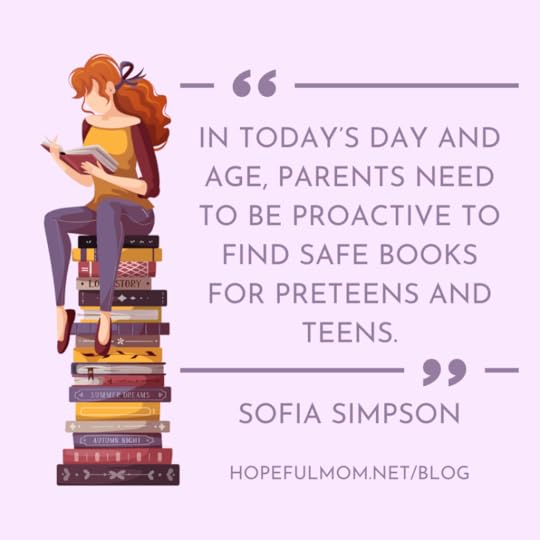 Conclusion
ConclusionHonestly, in today’s day and age you need to be proactive to find safe books for your preteens and teens. With the right strategies, you can navigate the literary landscape with more confidence and less fear. By analyzing blurbs for triggering words, using one-star and two-star reviews to uncover potential issues, leveraging online resources, utilizing Instagram and Facebook for Clean Reviewers, finding publishers you can trust, you can ensure the books your child reads are both enjoyable and appropriate for their age. It’s about finding stories that inspire, educate, and resonate with young readers…without the negative content.
As a Young Adult Christian Fantasy Author, I am dedicated to providing safe content for teens to read. It’s why I began writing in 2012. I was a public teen librarian and the books coming into my section horrified me. I have begun a social media campaign to force publishers to rate their books of sexual content, language, and violence. Find on Instagram and Facebook: Books Need Ratings and join my fight to protect our children by providing these ratings. Books today are not a safe place for our children. We need to fight back demanding ratings. I’ve written letters to my state senators and governor asking for a change. I want to have enough social media presence and high enough numbers to attract national attention. But I need your help. Follow Books Need Ratings on Instagram: https://www.instagram.com/booksneedratings/ and Facebook: https://www.facebook.com/groups/booksneedratings to join my fight for ratings on books. If you have any questions, feel free to contact me at sofia@sofiasimpson.com or find me at www.sofiasimpson.com or on Instagram or Facebook. I’d be happy to answer any questions. Please note, I’m not trying to ban or censor books, I’m just asking for books to have ratings for sexual content, language and violence.
The post Preteen and Teen Books: A Guide for Finding Safe Reads appeared first on HOPEFUL MOM.
September 2, 2024
Healthy Relationships in a Sexualized Culture
Our sexualized culture heavily influences the next generation. Whether they’re swiping through their social media feed, binging a show, reading a book, or hanging out with peers, there’s no escaping messages that steer them away from healthy relationships and towards unhealthy paths.
Parents try to counter cultural expectations, explaining why the latest greatest isn’t the best option. We’re on the defense. A friend persuades our child to install Snapchat. Swat. “Snapchat’s bad.” An influencer talks up an OnlyFans account. Whack. “Don’t show your stuff to strangers.” A partner says everyone’s doing it. Smack. “That’s not true. You’ll be sorry.”
Yes, we need to pay attention to their environment, listen to their thoughts, and offer valid reasons behind our “no” decisions. However, we should also present alternative solutions. Be on the offense. Talk about and model healthy relationships.
Let’s look at four habits of healthy relationships. (You can find an entire chapter on each of these in Sexpectations: Helping the Next Generation Navigate Healthy Relationships.)
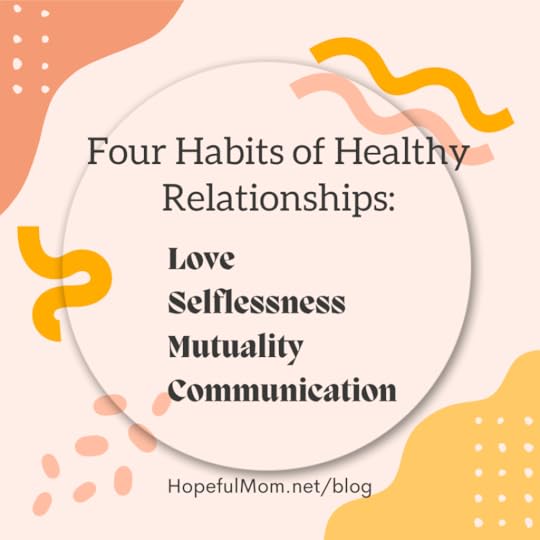 Love
LoveThe foundation is love—the love imbedded in us by God. “When we allow God to fill us with his love and acceptance, we subsequently love others well because his love overflows from us to those around us.” (Sexpectations, p. 65)
Healthy relationships start with a love that shows kindness, gentleness, and patience. Love that puts the other person’s needs above their own wants. This love is persistent, non-judgmental, and accepting. We love who the person is at their core (even when their behaviors are not acceptable and need addressed).
Before we can help our children understand what healthy relationships look like, we should examine our own. Are our relationships healthy? Do we model relationships built on the foundation of love?
SelflessnessI can think of no other human relationship which demonstrates selflessness better than parenting a child. Rearing children requires putting our desires aside at times. It means tending to the baby’s cries when all you want to do is sleep. It means crossing the room and picking up your toddler after they’ve fallen, even though you just sat down. And it means answering the phone and listening to your college-aged teen tell you about their day when you’ve got work waiting. Oh, but the rewards are great! When we see children as God sees them, they aren’t a chore or a task. They’re a privilege and a blessing.
When we love our children selflessly, we tend to their longings. Not just life-sustaining needs like food, water, air, and shelter. But these emotional longings as well: love and acceptance, safety and security, belonging, validation and feeling valued. If preteens and teens don’t find these needs within their own family unit, they will find them elsewhere.
A word of caution: Selflessness shouldn’t be confused with doormat or pushover, especially in the area of sex. Often, societal portrayals of sexual encounters do not model selflessness. Instead, these depictions are distorted, selfish, and objectifying.
Mutuality“Mutuality means sharing and supporting each other. Healthy, loving relationships show mutual respect, influence, and accountability. Each person encourages the other in their dreams, goals, and aspirations while being loyal, honest, and trustworthy. They do life together. Their love is reciprocal. Define mutuality and direct the next generation to healthier interactions and attitudes concerning partnerships, friendships, and marriage.” (Sexpectations, p. 97-98)
The objective is to equip the next generation with tools necessary to distinguish which behaviors within a new relationship are healthy and which aren’t. Then they will look for positive and negative indicators.
Parents, we want to equip the next generation with tools necessary to distinguish which behaviors within a new relationship are healthy and which aren’t. Healthy Relationships in a Sexualized Culture #healthyrelationships #hopefulmom
Share on X
Examples of negative indicators or red flags include someone: calling them names, not respecting boundaries, making all the decisions, or isolating them. When around this person, they might feel intimidated, inadequate, guilty, stupid, pressured, or trapped.
On the other hand, green flags include the other person: trusting them, encouraging them to have interactions with others, valuing their thoughts and opinions, treating them with kindness, respecting them, following through on their word, and celebrating their successes. When around these types of people, they feel loved, respected, valued, safe, secure, and able to be their true self.
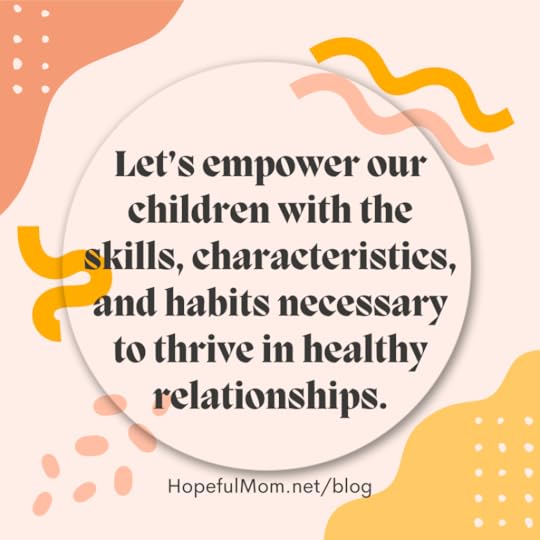 Communication
CommunicationIn healthy relationships, we communicate with the purpose of shared understanding and knowing each other more intimately, as well as expressing ideas and solving problems. It’s a form of connection. When our children feel that connection with us, they trust us and take our advice to heart, which is important, especially when talking about sensitive topics.
Parents, we are affecting the next generation. Let’s empower our children with the skills, characteristics, and habits necessary to thrive in healthy relationships. You’ve got this!
 SHE Summit
SHE SummitI am speaking on “Healthy Relationships in a Sexualized Culture” at the FREE SHE Summit September 16-20, 2024. “Throughout this 5-day virtual event, 40+ experts and storytellers will share their stories, their expertise, and their hope for meaningful recovery from pornography addiction and other unwanted sexual behaviors. Topics will range from recovery, to trauma and abuse, to identity and shame, to faith, the Church, advocacy, mental health, and others. This faith-based, online summit will answer the questions many women are asking and lead them safely into the process of recovery.
In addition, this event is for the Helper. Counselors, coaches, parents, church leaders, and others will better understand these issues to help women in recovery—plus opportunities for Q&A.” When registering for this summit, please use the code HOPEFUL for 10% off extended access or lifetime access.
The post Healthy Relationships in a Sexualized Culture appeared first on HOPEFUL MOM.
August 19, 2024
Comparing Healthy Sexuality, Purity Culture, and Pornified Mindsets
Some of Hopeful Mom’s readers are Christians. Some aren’t. Whether you subscribe to a Christian theology or not, this post from guest Cody Moen of Restoring Hearts Counseling can help you understand other viewpoints. The chart at the end contains especially helpful information regarding the difference between a pornified mindset, a purity culture mindset, and a healthy sexuality mindset. Thank you, Cody, for your insight.
One of the most common Bible verses repeated in addiction recovery material is Romans 12:2, “Do not be conformed to this world, but be transformed by the renewal of your mind.” Renewal of the mind occurs through reading, hearing, and doing God’s Word, baptism, and the sacraments. The mind is renewed as the former way of life without Jesus is put to death and a new way of life is lived out.
My own life is an example of this small bit of theology played out in the real world.
Renewal can occur in small ways, such as the way we speak. Before I knew Jesus my language, at best, was “colorful,” as it was shaped by secular, public school culture and life in the military. After I came to believe in Jesus, this colorful language faded and felt more foreign. Until I stub my toes, of course.
Renewal can occur in huge ways, also, such as completely altered lives. Before I knew Jesus, I detached from any intimate relationships, isolated, alone, and living in a world of dark, suffering silence. After I came to believe in Jesus, this renewal occurred over several years and is ongoing today. Now I have more relationships than ever. I’m connected and have been experiencing grace upon grace.
Renewal and transformation to be conformed to the image of God is good and should be pursued as in a race. Yet, this race a Christian runs can be sidelined by “well-intentioned” teachings that are actually harmful. Purity culture is an example of a well-intentioned teaching that may have done more harm than good.
Purity CultureI did not experience purity culture growing up—having been a heathen (I say this amusingly) most of my life—so I was not in church often enough to see it. What I have heard from Christians about purity culture, however, makes me glad I did not experience it. From what I gather, purity culture started sometime in the 1990’s to the early 2000’s with a good, solid goal of encouraging sexual abstinence until marriage. Somewhere along the line, however, sexual abstinence became “sexual purity” instead. Sexual thoughts and feelings were bad (read, “impure”) and made a Christian sexually impure. Sexual thoughts, feelings, and anything resembling them had to be stopped, prevented, and avoided.
"Purity culture's 'renewal of the mind' theology had real world effects . . . unhelpful . . . and damaging." ~ Cody Moens Comparing Healthy Sexuality, Purity Culture, and Pornified Mindsets #fightthenewdrug #purityculture #hopefulmom
Share on X
Purity culture’s “renewal of the mind” theology had real world effects, though these effects were, at best, unhelpful and, at worst, damaging. These teachings discouraged young Christian men and women from dating, men had to bounce their eyes from women, women had to dress so as not to tempt men, etc. Sexual feelings were to be suppressed by “making war” upon lust, then somehow, like flipping a switch, embraced when the young Christian man and woman married.
Purity culture fostered an environment where Christian men did not have to take responsibility for their sexual thoughts and actions. At the same time, that responsibility was placed into the hands of women. For both Christian boys and girls, shame increased from the inevitable sexual thoughts and feelings they had as they grew up and went through puberty.
Purity Culture Mindset vs Healthy Sexuality MindsetPurity culture mindset, though well-intentioned, is not the kind of renewal Romans 12:2 refers to. Sex and sexuality in God’s Word are not to be feared or avoided, as purity culture would teach. They are to be redeemed and cherished as great gifts that God designed them to be in a marriage between a man and woman. For God certainly does not seem as prudish as purity culture when He talks about sex and sexuality. Proverbs 5:18-19 encourages a young man (or young woman) to always take delight, even sexual delight, in his or her spouse. The entirety of Song of Songs is a husband and wife expressing this same delight—and yes, even sexual delight! —for one another.
Indeed, God does say in that same chapter of Proverbs and in Song of Songs that there are dangers to sex and sexuality. Yet, we have to remember that God created sex and sexuality in the beginning, blessed it, and said it was “very good” (Genesis 1:28, 31). It is sin which distorts God’s good creation and makes sex and sexuality dangerous. Although purity culture may have been well-intentioned about the danger of sexual sin, it confused sin, sex, and sexuality and turned what God created into a wholesale sin.
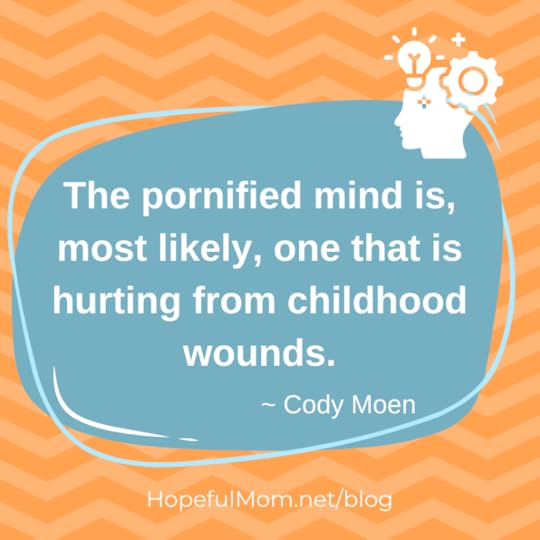 The Pornified Mind
The Pornified MindLet’s consider someone seeking help to overcome a porn or sex addiction. The pornified mind is, most likely, one that is hurting from childhood wounds. This mind is filled with shame and fear, which leads to isolation and hiding who they are from others. Relationships are surface level—if that! —as they objectify others in sexual fantasy for their own needs. A person with this mindset who is, by God’s grace, seeking help is not likely to look for it in a purity culture church.
On the other hand, a church that cherishes God’s gift of sex and sexuality in marriage, while not condoning sexual sin or confusing sin and sex, is a safer, more approachable place for a person seeking help with a porn or sex addiction. Such a place is where God’s Word can deeply renew such a pornified mind. For in such a place they will read, hear, and see in the congregation God’s Word being lived out.
Considering how many Christian men and women struggle with pornography alone, there is a need for transformation and renewal of the Church to no longer conform to purity culture, but to what God says about His creation of sex and sexuality.
(Charts adapted from Husband Material, Drew Boa)
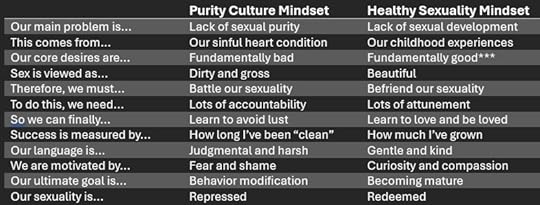
(***Fundamentally good as in, the desire to love and be loved is good. Yet, because of original sin we donot know how to fulfill this desire in Godly ways.)
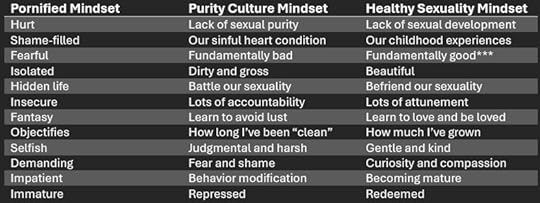
(***Fundamentally good as in, the desire to love and be loved is good. Yet, because of original sin we donot know how to fulfill this desire in Godly ways.)
When we understand the differences among these mindsets, we gain insight into the minds of the next generation and are able to help them walk away from behaviors that are not healthy and choose only healthy sexual behavior.
For curriculums to help you explain God’s design for sex to your children, visit this page. To schedule a one-on-one appointment with Founder Barb Winters, visit this page.
If you’re new to the Hopeful Mom community, this short video tells a little about us.
The post Comparing Healthy Sexuality, Purity Culture, and Pornified Mindsets appeared first on HOPEFUL MOM.
August 5, 2024
7 Back to School Preparations for Teens
A Webinar for You!
Hopeful Mom and Hope After Betrayal have joined forces to sponsor a webinar, Tackling Sensitive Conversations with Confidence. This webinar is designed to equip you with the tools and confidence to help your children navigate a sexually-saturated world in healthy and informed ways. Please join us! For more information and to register, click here.
7 Back to School Preparations for TeensI love walking into a store and seeing school supplies front and center, just waiting for excited children and (maybe-not-as-excited) parents to snag discounted items. If my inner-organizing-self had it her way, she’d rush to the notebooks and Post-it notes and pile them in her cart. But, alas, my children are grown, and notebooks on my shelf still await usage.
Maybe you look forward to back to school shopping. Or not. Either way, teens are headed back to school. And we need to prepare, physically and mentally.
Besides clearing the closet and making room for new shoes, backpacks, and lunch items, how can we prepare for back to school days?
1 – Structure the day for maximum back to school success.Most of us, teens included, function best when our days are structured. Discuss time needed for hygiene, breakfast, and last-minute tasks in the morning. Schedule shower/bathroom times for each child to avoid morning arguments. Help them determine a consistent bedtime and time for their morning alarm. Have nutritional breakfast options on hand. And, while we’re talking about food, stock up on healthy snacks for a quick after-school bite.
As part of the day’s structure, talk about screen time/social media time. Will there be limits on their phone? Will they need to shut their phones/computers off at a certain time each evening? Incorporate conversations about online safety.
2 – Consider organizations and/or extracurricular activities for your teen to join.Children learn time management skills, organizational skills, and how to get along with others through these pursuits. Additionally, when they participate in group activities and organizations, they are engaged in more face-to-face time and less screen time.
3 – Practice refusal skills.Because of their need to belong, a teen may succumb to peer pressure in order to fit in. Before the first day of school, ask your child how they will respond if someone asks them to vape, offers them alcohol, or attempts to show them something on their phone. (A good response to the phone scenario is asking, “What are you about to show me?” This may keep them from seeing a pornographic image.) What will they say if they’re invited to a party with drinking or no adult supervision? Role play scenarios and ask them to practice their responses. This may sound elementary and your teen could roll their eyes, but simply having the conversation tells them you understand what they face each day and you care about their well-being.
Back to school can be a difficult transition. But it doesn’t have to be. Plan ahead, and then be flexible. Read post for 7 Back to School Preparations for Teens #hopefulmom #healthyrelationships #backtoschool
Share on X
If you’re home, greet your teen as they walk in the door. Hang out in a common space, like the kitchen or living room. Discern your child’s temperament, and ask open-ended questions. Listen as they talk about their day. Allow them to decompress and express their hurts and struggles without judgment. We want our children to see us as a safe space where they can share their enthusiasm and their anxiety.
5 – Pay attention to red flags.Whether your teen is excited or anxious about returning to school, the first several weeks can be stressful. That’s typical. Their stress level should normalize as they learn new routines and connect with friends. Look for signals that something is amiss. Possible red flags include: withdrawal, isolating, a change in appearance, more anxious or depressed, a lack of motivation, asking not to go to school, irritability, and anger. This list is not complete, nor are these signals indications something is definitely wrong. However, if any arise, you may want to investigate.
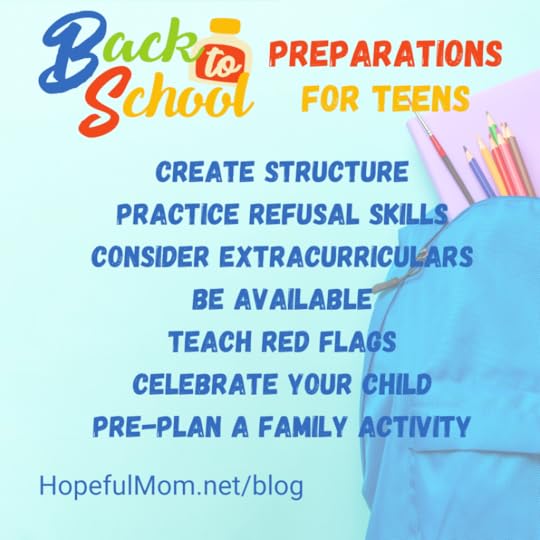 6 – Celebrate.
6 – Celebrate. Ask your teen the high point of their day. Show enthusiasm and excitement for any achievement or “win,” great or small. Congratulate them for trying something new or outside of their comfort zone. Find something to applaud. Be their biggest cheerleader.
7 – Pre-plan a family activity.Before school begins, as a family, plan an activity or outing for the first weekend school starts. It can be a family night of pizza and games, attending a local sporting event, or a weekend away—something your children can look forward to. Ask everyone to contribute ideas and ensure each person has at least one part they’re looking forward to. They could select the destination, the place you’ll eat, or games you’ll take. Maybe they can choose a new outfit to wear.
Back to school can be a difficult transition. But it doesn’t have to be. Think ahead. Plan, and then be flexible. And remember to add margin in each calendar day. Let’s do our best to help our teens thrive and succeed!
New Coaching OpportunityWould you like one-on-one coaching? I’ve joined 423Communities and 423Next to offer parents an opportunity to chat. I help parents understand their emotional responses to their child’s behavior and find their next steps to healing and effective parenting. I’d love to connect with you, offer a virtual hug, and provide practical advice and hope. Schedule your online call here.
ON SALE!The audio version of Sexpectations is on sale for $8! Wow! What a deal. Get your copy HERE today.
The post 7 Back to School Preparations for Teens appeared first on HOPEFUL MOM.



